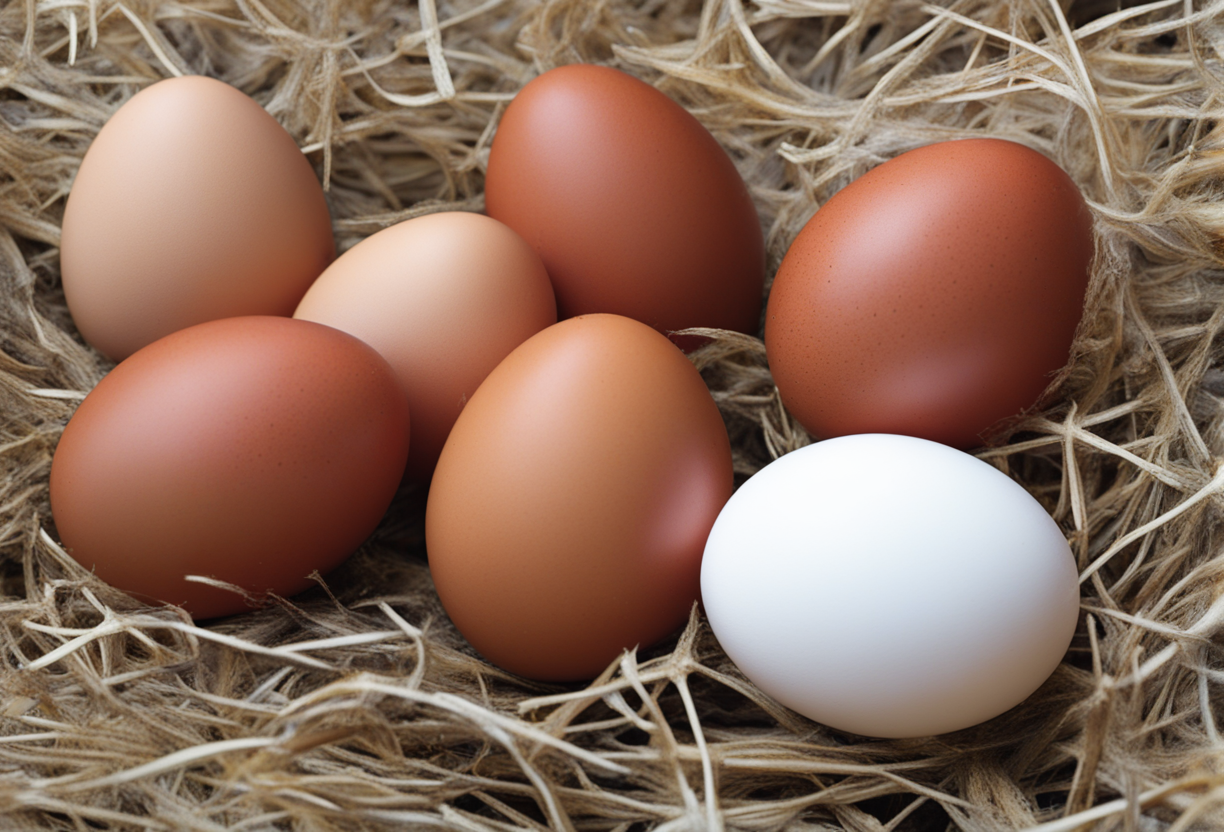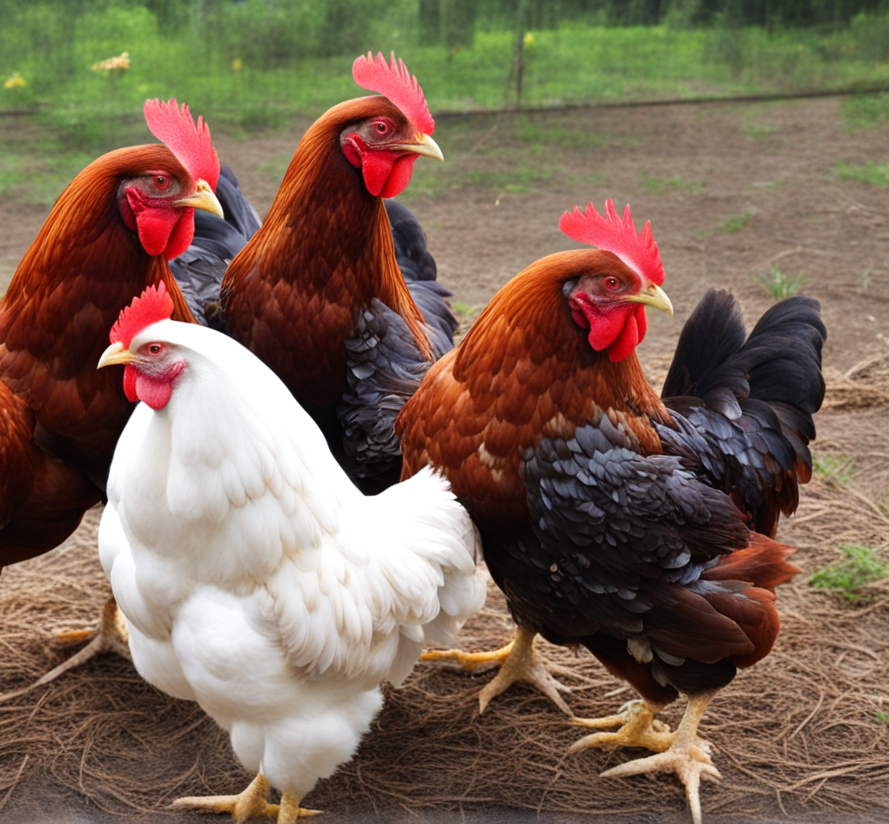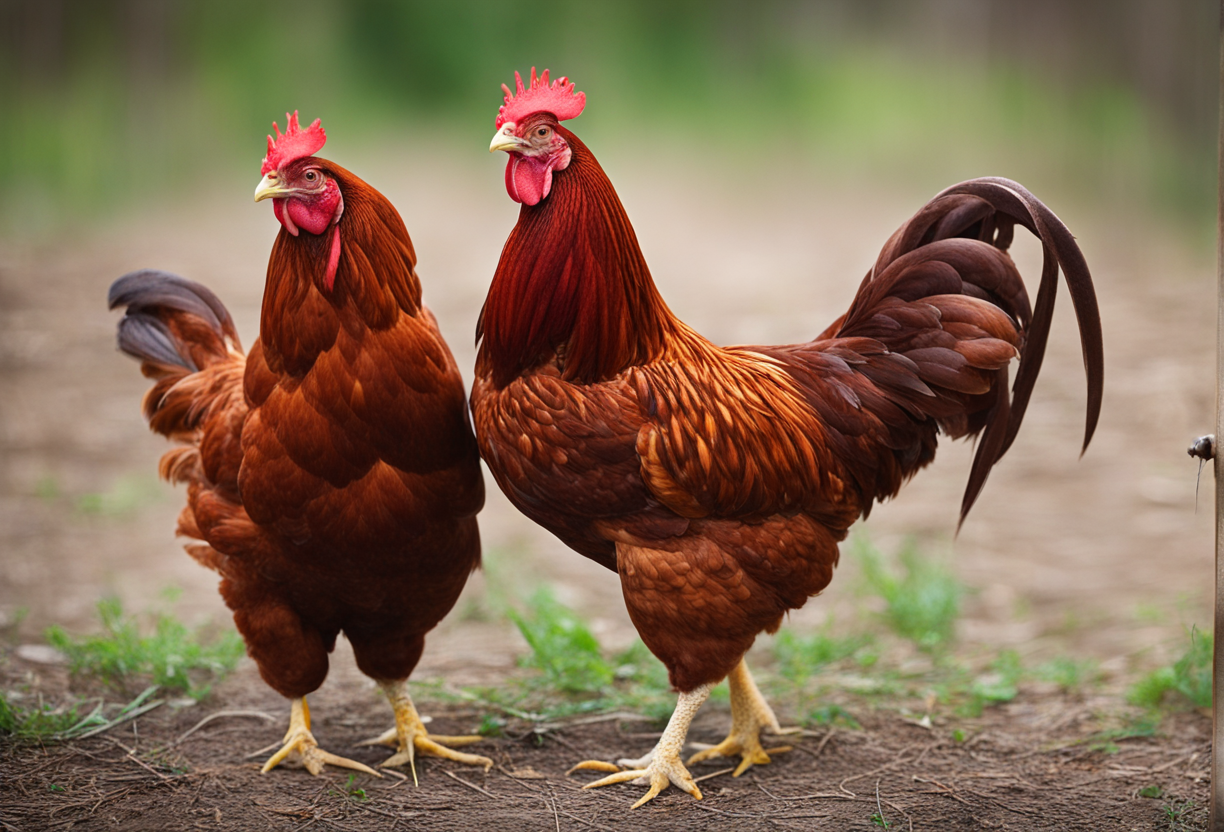As a backyard chicken keeper for over 5 years, I’m often asked which breed is best.
My go-to answers are usually Rhode Island Red or Red Star.
Both are excellent dual-purpose birds, meaning they lay lots of eggs and produce meaty carcasses.
But each breed has unique qualities to consider before deciding which is right for your flock.
Let me tell you about the time I bought my first chickens.
I was eager to get fresh eggs from my own hens, so I rushed out to the feed store and bought six baby Rhode Island Red chicks without doing any research.
Big mistake!
Those crazy girls scratched up all my flower beds and constantly bullied my poor Buff Orpington.
Their egg production maxed out at around 3-4 eggs per week, not the 5-6 I was hoping for. And the rooster was so aggressive, he attacked my poor kids when they tried to collect eggs!
After that fiasco, I wised up and spent time researching breeds before getting my next batch of chicks.
That’s when I discovered Red Stars.
Now those are some prime layers! My hens easily produce 5-6 big brown eggs a week, sometimes more in peak season.
Red Stars also have a well-earned reputation for being gentle and friendly.
They actively forage in the yard but leave my flowers and vegetables alone.
The rooster keeps a watchful eye on his flock but has never been aggressive towards my family. For a productive backyard flock and kid-friendly personality, Red Stars are my top choice.
For maximum eggs and a docile temperament, go with Red Stars.
Rhode Island Reds are better for large operations focused strictly on egg production.
Table of Contents
Egg Laying
Rhode Island Reds will lay around 200-300 eggs per year if well cared for.

That’s a respectable amount for most backyard flocks.
However, Red Stars can lay up to 328 eggs annually and sometimes more! My Red Star flock of 10 hens produces about 50-60 eggs per week at peak production.
Red Stars also continue laying eggs consistently through cold winter weather when many chickens stop. They mature and reach peak laying faster than Rhode Island Reds too – usually around 5-6 months vs. 6-7 months.
I’ve found I get larger, more frequent eggs from my Red Stars starting earlier in their first season. Rhode Island Reds produce decently but mine slowed down over winter despite supplemental lighting and feeding. For maximum eggs, especially in cold climates, Red Stars are the clear winner here.
Temperament
Without a doubt, Red Stars win when it comes to temperament and suitability for small flocks. Every chicken has its own personality, but Red Stars tend to be calm, friendly birds compared to other breeds.

Mine follow me around the yard! They are totally docile and love being picked up and petted. I have young nieces and nephews who chase the chickens around – the Red Stars don’t mind the attention.
Rhode Island Reds can be much more assertive, even aggressive – especially the roosters.
The hens can be flighty and nervous too. Rhode Island Reds may do better in large free-range operations where they have plenty of space to establish a hierarchy. But for small suburban backyards, Red Stars are ideal.
Cold Hardiness
Both Rhode Island Reds and Red Stars can handle cold winter weather thanks to their full feathering. However Red Stars really excel in cold tolerance and egg production.

Last winter we had a brutal stretch of sub-zero days here in Vermont. My Red Star flock missed maybe one or two days of laying but otherwise kept up production.
I had to run power cords and heat lamps to keep the Rhode Island Reds laying more than an egg or two each week during that cold spell.
If you live in a northern climate with snowy winters, Red Stars will give you eggs consistently while most breeds slow down. Their egg production and cold hardiness makes them ideal for winter laying.
Meat Production
For the small scale farmer or homesteader who wants dual purpose birds, both Rhode Island Reds and Red Stars produce nicely sized birds for meat.

Reds and Red Stars both grow quickly thanks to their foraging abilities and hearty appetites. I butcher excess roosters around 18-20 weeks and get a good 4-5 pounds of plump breast meat.
The broad-breasted Red Star strain has been specifically bred for increased breast size and meat production. If you’re raising a large number of chickens mainly for meat rather than eggs, the Red Stars might have an advantage. But both are excellent dual purpose breeds when it comes to carcass size and quality.
Appearance
When it comes to looks, Rhode Island Reds certainly win points for their stunning plumage. The rich mahogany red feathers befitting the breed’s name are really eye-catching.
Red Stars show more variation in color with both red and black feathering. The black tail feathers are actually useful for keeping hawks and predators from spotting them! Both Rhode Island Reds and Red Stars have the typical yellow skin and legs.
For ornamental qualities, the Rhode Island Reds are hard to beat. But the Red Star’s varied plumage allows them to blend into their surroundings and evade aerial predators.
Cost
Baby Rhode Island Red chicks tend to cost a dollar or two less upfront than Red Stars. But once you account for the increased eggs you get from Red Stars, the cost difference becomes negligible.
As an example, my local farm store charges $4 for Rhode Island Reds vs. $5 for Red Stars. Over their first laying season, the Red Stars will produce easily 50 more eggs than a Rhode Island Red.
At Farm Stand prices, that more than makes up the initial price difference between the two breeds. For homesteaders and small farmers who need maximum production, Red Stars deliver more value over their lifespan.
As you can see, both heritage breeds have their merits and advantages.
For smaller flocks with limited space, I recommend Red Stars for their friendly temperament, stellar egg production and cold weather vigor.
But for large operations with room to roam, Rhode Island Reds may be a better fit to realize their full laying potential. Do your research and choose the right breed for your needs. Let me know if you have any other questions!
Feeding
Both Rhode Island Reds and Red Stars are vigorous foragers that do well on pasture and free range. This helps reduce feed costs compared to more sedentary breeds.
However, Red Stars seem particularly adept at finding natural food sources. Mine routinely hop fences or fly over to access my neighbor’s feed bins! So be prepared to Red Star-proof your coops and feed storage areas.
These breeds have hearty appetites and require around 16-20% protein feed to sustain egg production. I supplement with oats, vegetables, fruit and table scraps.
Red Stars seem to tolerate a wider range of feed better than Rhode Island Reds. I’ve found Rhode Island Reds lay better with higher protein feed or pellets. Both breeds are prone to going broody, so avoid too much calcium during peak laying season.
Because Red Stars lay more frequently, they eat more too. Budget around 1/4 lb of feed per Red Star hen daily. Rhode Island Reds may get by on slightly less around 1/5 lb per hen.
But don’t skimp on feed – well-fed hens will lay better and avoid bad behaviors like feather pecking. Provide good access to insoluble grit to aid digestion. And make sure clean water is always available – egg production takes lots of hydration!
Broodiness
Rhode Island Reds and Red Stars are both breeds prone to broodiness thanks to their heritage as setting hens. This instinct is great if you want a hen to hatch eggs and raise chicks. But for continuous egg laying, broodiness must be discouraged through nesting box management.
I’ve found Red Stars tend to get broody a bit less than Rhode Island Reds. My Red Stars may try to set early in the season but are easily broken of the habit once laying is in full swing. Yet my Rhode Island Reds seem determined to go broody every summer no matter what I try!
Use open-bottom nest boxes, limit nesting material and collect eggs frequently. Isolate broody hens in a wire-bottom coop until they resume laying. Hormone supplements like phytoestrogen can also reduce broodiness. Just be patient – stubborn broody hens may take weeks to start laying again.
Predator Awareness
Both Rhode Island Reds and Red Stars have a strong prey drive and foraging instinct. This makes them alert and wary birds compared to docile breeds like Orpingtons. Reds and Red Stars will sound the alarm at approaching predators quickly.
However, Red Stars seem more attuned to overhead danger from hawks or aerial predators. Their black-and-red speckled plumage helps them blend into leaf litter and dirt. Rhode Island Reds’ all-red feathers stand out in the open. Several times I’ve had hawks pick off Rhode Island Reds while foraging yet leave the Red Stars alone.
To protect your flock, provide cover for shelter and roosting. Thick hedges, brush piles and covered runs help obscure chickens from predators. Always enclose outdoor runs with wire tops or netting to prevent attacks.
Climate Adaptability
Both Rhode Island Reds and Red Stars handle a wide range of climates thanks to their hardy constitutions and full feathering. From heat waves to blizzards, backyard flocks thrive in most environments.
However, Red Stars excel in extremely hot or cold weather compared to Rhode Island Reds. Their active foraging ensures they find shade and water on hot days. And Red Stars seem less bothered by heat while foraging than Rhode Island Reds.
We’ve already covered how Red Stars handle cold and wintry weather better. Their egg production persists through conditions that cause other hens to stop laying. So in very cold northern or mountain climates, go with Red Stars.
These breeds have some heat tolerance but avoid areas with sustained 100+ temperatures. Provide shade, ventilation and cool water in summer. And bring birds indoors or use heating lamps if temperatures drop far below zero for extended periods.
Flock Integration
Introducing new chickens to a flock should be done slowly and carefully to prevent conflict. Both Rhode Island Reds and Red Stars integrate well with proper precautions.
I’ve found Red Stars to be a bit less territorial than Rhode Island Reds when adding new flock members. Red Stars are so focused on foraging they ignore newcomers after a few days. Rhode Island Reds seem to feel more challenged by new additions.
House new chickens separately for a quarantine period before introducing them. Let the flock see and become familiar with each other through a wire barrier first. Supervise initial full interactions and remove bullying birds if needed.
Adding younger pullets allows them to mature within the existing hierarchy instead of challenging it. Having multiple new additions avoids singling out one new chicken for pecking. Proper introductions and patience will let both of these breeds fully integrate into the flock.
Rhode Island Red vs Red Star Chart
| Rhode Island Red | Red Star | |
|---|---|---|
| Origin | United States | Hybrid |
| Size | Medium | Medium |
| Color | Red | Red |
| Temperament | Friendly | Docile |
| Egg Production | High | High |
| Egg Color | Brown | Brown |
| Feather Color | Red | Varies |
| Comb Type | Single | Single |
| Broodiness | Moderate | Low |
| Hardiness | Excellent | Good |
| Weight (Hen) | 6.5 lbs | 5.5 lbs |
| Weight (Rooster) | 8.5 lbs | 7.5 lbs |
| Lifespan | 5-8 years | 2-4 years |
| Special Notes | Adaptable and good for beginners. | Known for consistent egg production. |
| Climate Tolerance | Warm climates | Adaptable to various climates |
| Feeding Requirements | Standard poultry feed | Efficient feed converters |
| Health Issues | Resilient, but watch for common poultry diseases | Generally healthy |
| Egg Size | Large | Large to Extra Large |
| Foraging Ability | Good foragers | Excellent foragers |
| Use | Dual-purpose (meat and eggs) | Egg production |
